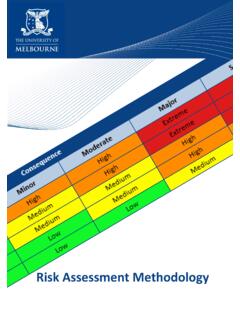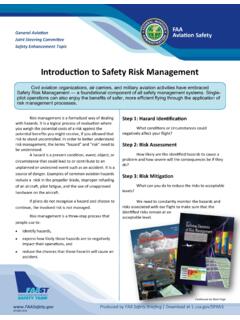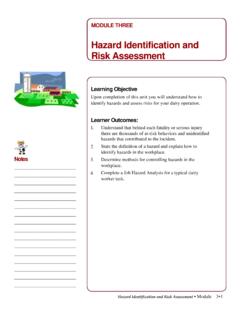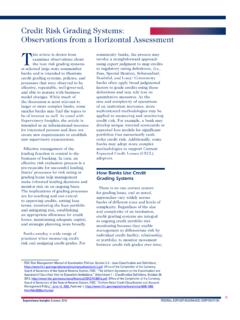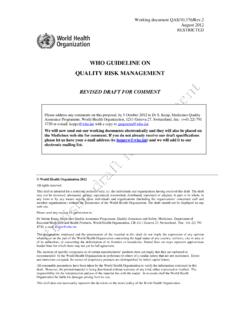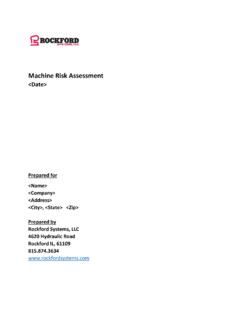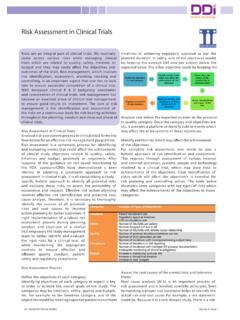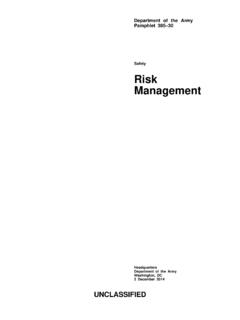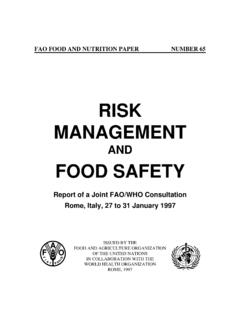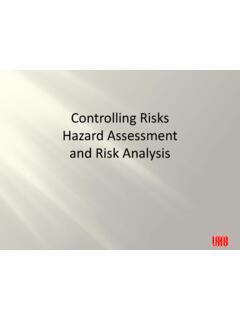Transcription of Risk Assessment Methodology - Health and Safety
1 Risk Assessment Methodology RISK Assessment Methodology Date: May 2018 Version: Authorised by: Manager, Health & Safety , Operations Next Review: May 2023 The University of Melbourne Uncontrolled when printed. This document has been developed to support The University of Melbourne s risk Assessment Methodology and the Health & Safety : Risk management requirements. Health & Safety : RISK Assessment Methodology i Date: May 2018 Version: Authorised by: Manager, Health & Safety , Operations Next Review: May 2023 The University of Melbourne Uncontrolled when printed.
2 TABLE OF CONTENTS 1 INTRODUCTION .. 1 SOFTWARE APPLICATION .. 1 HARD COPY APPLICATION .. 1 CONSIDERATIONS .. 1 2 RISK SCORING/ANALYSIS .. 1 USING THE TWO VARIABLE RISK MATRIX .. 1 INHERENT RISK AND RESIDUAL RISK .. 2 3 RISK CONTROL MEASURES .. 3 4 HIERARCHY OF CONTROL .. 3 5 Health AND Safety ACTION PLANS .. 5 ERMS Health AND Safety ACTION PLANS .. 5 HARD COPY Health AND Safety ACTION PLANS .. 5 6 HAZARD SPECIFIC AND GENERAL RISK ASSESSMENTS .. 6 ERMS .. 6 HAZARD-SPECIFIC RISK Assessment FORMS .. 6 GENERAL RISK Assessment FORMS .. 7 MANUFACTURE OF PLANT AND EQUIPMENT, INCLUDING REGULATED PLANT.
3 7 HIGH CONSEQUENCE OPERATIONS .. 7 DESIGN OF NEW BUILDINGS OR STRUCTURES, AND BUILDING REFURBISHMENTS .. 8 ACQUISITION AND LEASING OF BUILDINGS AND OPERATIONAL ENTITIES .. 9 7 REFERENCES .. 10 APPENDIX A: Health & Safety RISK MATRIX AND DEFINITIONS .. 11 Health & Safety : RISK Assessment Methodology 1 Date: May 2018 Version: Authorised by: Manager, Health & Safety , Operations Next Review: May 2023 The University of Melbourne Uncontrolled when printed. 1 INTRODUCTION This document describes the Methodology for completing risk assessments, using the University of Melbourne s risk Assessment systems and processes.
4 It explains both the current software application and the hard copy application. Software application Risk assessments are entered and stored into the Enterprise Risk Management System (ERMS). A University username and password is required to access ERMS via the Staff Hub or directly from web site: Enterprise Risk Management System. Hard copy application Hard copy risk Assessment forms are available where access to ERMS is not available. These can later be transposed to ERMS. These are detailed in Section 6. Considerations Health and Safety risk assessments must consider the likelihood and consequence of injury, illness or incident occurring, based upon: relevant legal requirements; evaluation of available information; records of incidents, illness and disease; and potential for emergency situations.
5 2 RISK SCORING/ANALYSIS Using the two variable risk matrix University risk assessments use a two variable risk matrix for risk scoring/analysis. The two variable risk Assessment is aligned in both the software application and the hard copy application. The two variable risk matrix assesses the likelihood and consequence of a hazard. This Assessment determines the level of risk associated with the hazard. Likelihood is the probability that something might happen. Consequence is defined as the most probable result of the potential incident. NOTE: Under some circumstances an alternative risk matrix or Methodology may be used.
6 For example the chemical risk Assessment Methodology in GoldFFX. Health & Safety : RISK Assessment Methodology 2 Date: May 2018 Version: Authorised by: Manager, Health & Safety , Operations Next Review: May 2023 The University of Melbourne Uncontrolled when printed. Figure 1: Two variable risk matrix This section explains how to use the two variable risk matrix. Refer to Appendix A for likelihood and consequence definitions. Step 1: Consider the likelihood of the exposure to the hazard occurring. Using the table Likelihood , determine the likelihood of exposure to the hazard. Step 2: Consider the consequence of exposure to the hazard.
7 Using the table Consequence , determine as realistically as possible the consequence resulting from exposure to the hazard. Step 3: Using the two variable risk matrix, determine the risk rating from the likelihood and consequence descriptors. To use the risk rating matrix: In the column Likelihood of the risk matrix, locate the likelihood descriptor that was determined in the Step 1. In the row Consequences of the risk rating calculator, locate the consequence descriptor that was determined in Step 2. The risk rating is provided in the box where the likelihood column and consequence intersect. The following demonstrates using two variable risk matrix to analyse the risk associated with an activity.
8 Refer to table 2. Step 1: The likelihood for an activity is determined as unlikely Step 2: The consequence for an activity is determined as moderate . Step 3: The likelihood and consequence intersect at medium . Therefore activity has an associated medium risk. Figure 2: Determining risk using the two variable risk matrix Inherent risk and residual risk The University risk Assessment Methodology requires an analysis/score for both the inherent risk and the residual risk. Health & Safety : RISK Assessment Methodology 3 Date: May 2018 Version: Authorised by: Manager, Health & Safety , Operations Next Review: May 2023 The University of Melbourne Uncontrolled when printed.
9 The inherent risk, is the level of risk that an activity/hazard category would pose if no controls or other mitigating factors were in place. The residual risk is the level of risk associated with an activity after proposed/additional controls have been implemented to further eliminate or reduce the risk. Where proposed/additional controls are required the residual risk should be lower than the inherent risk. In some cases where the inherent risk may already be low , the residual risk will be the same. 3 RISK CONTROL MEASURES Following the risk analysis, the risk Assessment then determines the most effective control method to eliminate or reduce the risk so far as is reasonably practicable.
10 The hierarchy of control (see Section 5) is used to determine this method for eliminating or reducing the risk. The implementation of control priorities can be established based on the level of risk, available resources, timelines associated with the implementation of controls and so on. Where risk control prioritisation is required a plan must be developed (Section 4). Control measures must be implemented in accordance with the risk control priorities established during the risk Assessment . Control measures should include one or more of the following actions: eliminate or control the risk by applying an established control from an existing risk Assessment ; partially control the risk (including isolation) and refer to a more senior manager; request advice from a Health and Safety Business Partner; and/or refer to the local Health & Safety Committee for further Assessment .
